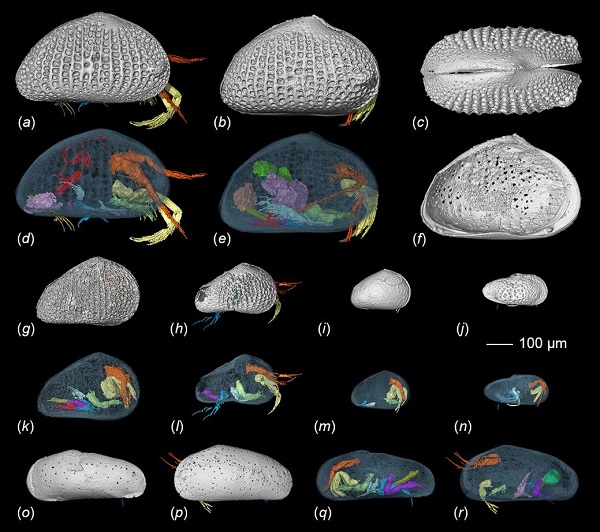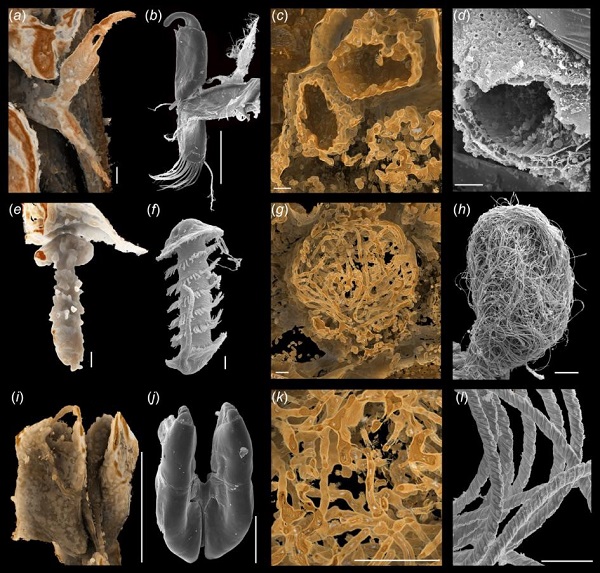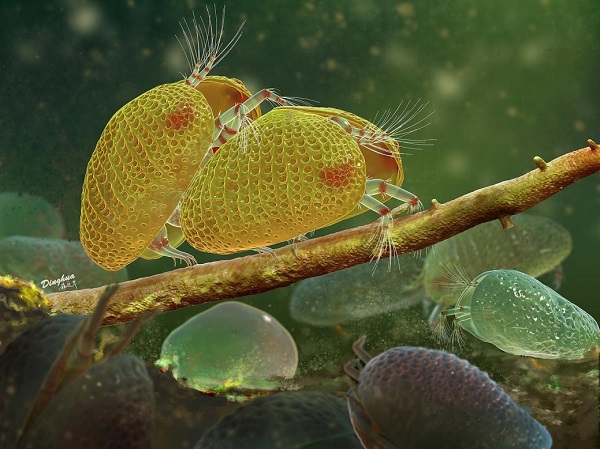The small bivalved crustacean ostracods are the most abundant fossil arthropods since the Ordovician and play an important role in paleoenvironmental reconstruction and evolutionary biology. Ostracods are also a good biostratigraphic indicator, which are very important in the oil-gas exploration. The vast majority of fossil ostracods are represented by calcified shells, and their soft parts are extremely rare but provide invaluable information of ancient ostracod autoecology.
Recently, Dr. WANG He and Prof. WANG Bo from Nanjing Institute of Geology and Palaeontology, Chinese Academy of Sciences (NIGPAS), and other researchers from Ludwig-Maximilians-Universitat München and Queen Mary University of London, presented exceptionally-preserved ostracods with soft parts (appendages and reproductive organs) from mid-Cretaceous Myanmar amber (approximately 100 million years old).
The ostracod assemblage is composed of 39 individuals in one amber piece and includes males, females and juveniles. X-ray micro-computed tomography was used to obtain high-resolution three-dimensional images of their soft parts. The micro-CT reconstruction provides direct evidence of the male clasper, sperm pumps (Zenker organs), hemipenes, eggs and female seminal receptacles with giant sperm.
For copulation, cypridoidean males use their sexually dimorphic fifth limbs, which have hook-like endopods, to grasp a female while introducing their hemipenes into the female’s paired vaginas. The male’s pair of Zenker organs then transfers the exceptionally long but immotile sperm via the male hemipenes into the female. The Zenker organ is readily identified in extant cypridoidean ostracods as a large, spiny, sclerotized part of the deferent sperm duct. Muscle fibers alongside the organ connect the numerous spines, which are often arranged in a number of whorls that are taxonomically characteristic at family level. Once in the female, the sperm are pushed up the two long sperm canals, each ending in a sac-like seminal receptacle for sperm storage; here, they finally become motile, arrange themselves into a more organized assemblage and fertilize eggs during the process of oviposition.
Research results reveal that the reproduction behavioral repertoire, which is associated with considerable morphological adaptations, has remained unchanged over at least 100 million years—a paramount example of evolutionary stasis. These results also double the age of the oldest unequivocal fossil animal sperm. The appearance of complex reproductive mechanism involving giant sperm improves mating success and may have been an important contributor to the late Mesozoic explosive radiation of the superfamily Cypridoidea, which today includes the vast majority of nonmarine ostracod species.
We are grateful to Vladimir Blagoderov, Ryszard Szadziewski, and Kornelia Skibińska for helpful discussions, WU Suping for helping with the micro-computed tomography reconstruction and YANG Dinghua for the artist’s reconstruction of the ostracods in life.
This research was supported by the Strategic Priority Research Program of the Chinese Academy of Sciences, the Second Tibetan Plateau Scientific Expedition and Research, and the National Natural Science Foundation of China.
Reference:Wang H, Matzke-Karasz R, Horne DJ, Zhao X, Cao M, Zhang H, Wang B. 2020 Exceptional preservation of reproductive organs and giant sperm in Cretaceous ostracods. Proceedings of the Royal Society B 20201661. http://dx.doi.org/10.1098/rspb.2020.1661.

The studied ostracods from Myanmar amber

Preserved body parts in fossils in comparison with modern analogues. (a) Right 5th limb of male with clasping organ (top). (b) Eucypris virens: right 5th limb of male with clasping organ (top). (c) Two eggs in female partly cut open. (d) E. virens: empty egg shell. (e) Zenker organ. (f) Cyclocypris ovum: Zenker organ. (g) Mass of sperms in location of seminal receptacle in female. (h) Mytilocypris mytiloides: densely packed sperm filling of a seminal receptacle. (i) Paired hemipenes. (j) Fabaeformiscandona subacuta: paired hemipenes. (k) Sperms in female. (l) Pseudocandona marchica: sperms in female

Artist’s reconstruction of ostracods in life (a mating pair) by YANG Dinghua
